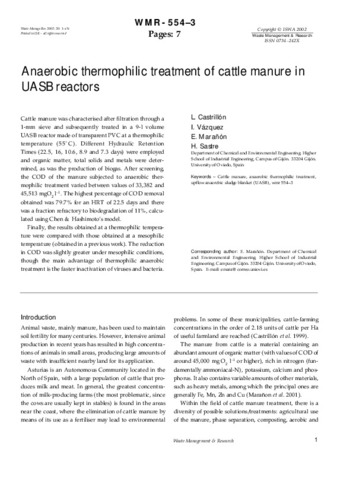Anaerobic thermophilic treatment of cattle manure in UASB reactors
Autor(es) y otros:
Palabra(s) clave:
Cattle manure
Anaerobic thermophilic treatment
Upflow anaerobic sludge blanket (UASB)
Fecha de publicación:
Editorial:
Sage
Versión del editor:
Citación:
Descripción física:
Resumen:
Cattle manure was characterised after filtration through a 1-mm sieve and subsequently treated in a 9-l volume UASB reactor made of transparent PVC at a thermophilic temperature (55°C). Different Hydraulic Retention Times (22.5, 16, 10.6, 8.9 and 7.3 days) were employed and organic matter, total solids and metals were determined,as was the production of biogas. After screening,the COD of the manure subjected to anaerobic thermophilic treatment varied between values of 33,382 and 45,513 mgO2 l–1. The highest percentage of COD removal obtained was 79.7% for an HRT of 22.5 days and there was a fraction refractory to Biodegradation of 11%, calculated using Chen & Hashimoto’s model. Finally, the results obtained at a thermophilic temperature were compared with those obtained at a mesophilic temperature (obtained in a previous work). The reduction in COD was slightly greater under mesophilic conditions, though the main advantage of thermophilic anaerobic treatment is the faster inactivation of viruses and bacteria.
Cattle manure was characterised after filtration through a 1-mm sieve and subsequently treated in a 9-l volume UASB reactor made of transparent PVC at a thermophilic temperature (55°C). Different Hydraulic Retention Times (22.5, 16, 10.6, 8.9 and 7.3 days) were employed and organic matter, total solids and metals were determined,as was the production of biogas. After screening,the COD of the manure subjected to anaerobic thermophilic treatment varied between values of 33,382 and 45,513 mgO2 l–1. The highest percentage of COD removal obtained was 79.7% for an HRT of 22.5 days and there was a fraction refractory to Biodegradation of 11%, calculated using Chen & Hashimoto’s model. Finally, the results obtained at a thermophilic temperature were compared with those obtained at a mesophilic temperature (obtained in a previous work). The reduction in COD was slightly greater under mesophilic conditions, though the main advantage of thermophilic anaerobic treatment is the faster inactivation of viruses and bacteria.
Colecciones
- Artículos [37321]
- Ingeniería Química y Tecnología del Medio Ambiente [351]
Ficheros en el ítem




